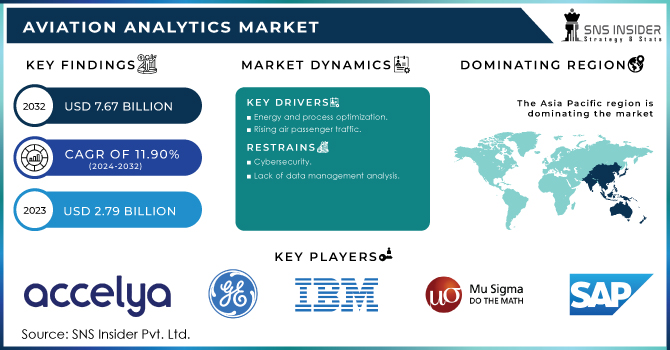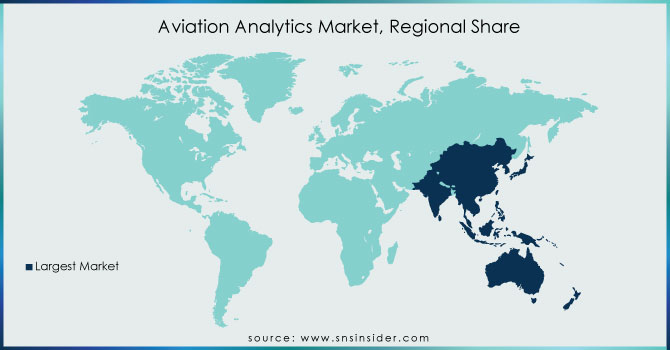Aviation Analytics Market Report Scope & Overview:

To get more information on Aviation Analytics Market - Request Free Sample Report
The Aviation Analytics Market Size was valued at US$ 2.79 billion in 2023 and is expected to reach USD 7.67 billion by 2032 with a growing CAGR of 11.90% over the forecast period 2024-2032.
Most businesses use aviation analytics because it allows them to better their operational effectiveness, profitability, and maintenance. Aviation analytics assists businesses in developing analytical solutions to meet future demand such as customer expectations, allowing them to maximize their operating revenue. Aviation analytics solutions are utilized in a variety of applications throughout the aviation sector, including fuel management, customer analytics, revenue management, and risk management. Aviation analytics solutions assist organizations in measuring, monitoring, and analyzing their business goals, risk, and future growth. Aeronautics includes the exercises encompassing the airplane business and mechanical flight. Investigation implies methodical computational examination of insights or information. Flying examination is a computational innovation that gives data or measurements of verifiable air terminal functional information, authentic flight information, weather conditions gauges, and continuous flight information to the end-clients. It grants prescient investigation and inquiry handling over huge aeronautics information. Basically, it offers expectations or arrangements in view of organized and unstructured huge flying information.
The worldwide flying examination market is driven by an ascent in center around cutthroat knowledge and ongoing scientific answers for increment the efficiency of a business. Additionally, consistent development in the volume of information produced in the avionics business, flood in aeronautics traveler traffic, and development in clients' centricity fuel the development of the market. In any case, inability to give information models as per the need of organizations and a shortage of scientifically gifted labor force hampers the market development. Running against the norm, ascend in the reception pace of examination and ceaseless mechanical progressions in the avionics business are supposed to give various chances to advertise extension in not-so-distant future.
MARKET DYNAMICS
KEY DRIVERS
-
Energy and process optimization
-
Rising air passenger traffic
-
Increasing volume data generated
RESTRAINTS
-
Cybersecurity
-
Lack of data management analysis
OPPORTUNITIES
-
Enhance Artificial intelligence
-
New enhance cloud-base technology
CHALLENGES
-
Lack of analytic skills
-
Requirement of versatile data models
IMPACT OF COVID-19
During the covid-19 period, the Aviation Analytics Market Trends influenced the dynamics and lowered sales and manufacturing rates. The Covid-19 has had an impact on the entire industry, lowering market rivalry and the worldwide supply chain.
The corona outbreak has caused a significant decrease in revenue, which has gradually increased in the year 2021. The covid-19 impacted the supply chain and altered the whole financial aspect of the Aviation Analytics Market Trends. This year, businesses began optimizing their operations and strategies in order to compete and survive. With the strategic actions of market main players and government regulatory bodies, the Aviation Analytics Market Outlook business is rising and acquiring new prospects.
The services segment is expected to develop at the fastest CAGR throughout the projection period. This segment's expansion can be attributable to rising demand for supply chain planning and inventory management services from airlines and airports. Lufthansa Technik provides aviation analytics consulting in the form of aircraft maintenance.
Some of the important elements driving the expansion of the airlines industry are the growing inclination for air travel and the installation of new air travel routes. Passengers from emerging economies tend to fly for both business and pleasure. Various programmer focusing on aircraft modernization are also boosting demand for aviation analytics, as customers desire convenience and safety features. As a result, the airlines segment is expected to drive the aviation analytics market.
The market is segmented into fuel the executives, flight risk the board, client investigation, route administrations, and others in view of utilization. Client examination is projected to be the quickest developing section in the market during the estimate time frame. This is because of the air terminals' section. The carrier portion is putting vigorously in knowing client inclinations and conduct and embracing client centricity by utilizing prescient examination to further develop direction. The route administrations fragment is gauge to be the second-most elevated developing portion. The route programming gives cockpit advancement arrangements, post-flight following capacities, ground vehicle following, and checking of flight developments, which assist the air terminal and air with dealing the board for better functional help. The flight risks the board portion is anticipated to feature a moderate development rate during the conjecture time frame. The expansion sought after to improve wellbeing and diminish functional issues helps the interest for flight risk the board programming. The fuel the board type fragment held a critical worth offer in 2022. The most noteworthy direct working expense of an airplane is fuel. Fuel the executives programming assists airlines with effectively following fuel utilization and control working expenses. Before very long, the interest for this portion is probably going to increment.
KEY MARKET SEGMENTATION
By Deployment
-
On-premise
-
Cloud
By End-User
-
MROs
-
Airlines
-
Airports
-
OEMs
By Component
-
Service
-
Software
-
Solutions
By Business Function
-
Sales & Marketing
-
Finance, Maintenance
-
Repair & Operations
-
Supply Chain
By Application
-
Flight Risk Management
-
Inventory Management
-
Fuel Management
-
Revenue Management
-
Customer Analytics
-
Navigation Services
REGIONAL ANALYSIS
The Aviation Analytics Market is expected to expand the most in the following year. North America, Europe, Asia Pacific, Latin America, and the Middle East and Africa are the regions that make up the market. Over the last few years, the Asia Pacific area has seen consistent expansion in the business. The region is assisting the market's expansion by increasing rising consumer expectations, functional efficiency, and the mounting cost-cutting push. Europe and North America are also likely to grow significantly in the Aviation Analytics Market in the future years.

Need any customization research on Aviation Analytics Market - Enquiry Now
REGIONAL COVERAGE:
-
North America
-
USA
-
Canada
-
Mexico
-
-
Europe
-
Germany
-
UK
-
France
-
Italy
-
Spain
-
The Netherlands
-
Rest of Europe
-
-
Asia-Pacific
-
Japan
-
south Korea
-
China
-
India
-
Australia
-
Rest of Asia-Pacific
-
-
The Middle East & Africa
-
Israel
-
UAE
-
South Africa
-
Rest of Middle East & Africa
-
-
Latin America
-
Brazil
-
Argentina
-
Rest of Latin America
-
KEY PLAYERS
The Major Players are Accelya, General Electric, International Business Machine Corporation (IBM), MU Sigma, Oracle Corporation, Ramco Systems, SAP SE, OAG Aviation Worldwide Limited, SAS Institute Inc, IGT Solutions Pvt. Ltd, and other players
| Report Attributes | Details |
|---|---|
| Market Size in 2023 | US$ 2.79 Billion |
| Market Size by 2032 | US$ 7.67 Billion |
| CAGR | CAGR of 11.90% From 2024 to 2032 |
| Base Year | 2023 |
| Forecast Period | 2024-2032 |
| Historical Data | 2020-2022 |
| Report Scope & Coverage | Market Size, Segments Analysis, Competitive Landscape, Regional Analysis, DROC & SWOT Analysis, Forecast Outlook |
| Key Segments | • By Deployment (On-premise, Cloud) • By End-User (MROs, Airlines, Airports, OEMs) • By Component (Service and Software & Solutions) • By Business Function (Sales & Marketing, Finance, Maintenance, Repair & Operations, and Supply Chain) • By Application (Flight Risk Management, Inventory Management, Fuel Management, Revenue Management, Customer Analytics, and Navigation Services) |
| Regional Analysis/Coverage | North America (USA, Canada, Mexico), Europe (Germany, UK, France, Italy, Spain, Netherlands, Rest of Europe), Asia-Pacific (Japan, South Korea, China, India, Australia, Rest of Asia-Pacific), The Middle East & Africa (Israel, UAE, South Africa, Rest of Middle East & Africa), Latin America (Brazil, Argentina, Rest of Latin America) |
| Company Profiles | Accelya, General Electric, International Business Machine Corporation (IBM), MU Sigma, Oracle Corporation, Ramco Systems, SAP SE, OAG Aviation Worldwide Limited, SAS Institute Inc, IGT Solutions Pvt. Ltd, and other players. |
| DRIVERS | • Energy and process optimization • Rising air passenger traffic • Increasing volume data generated |
| RESTRAINTS | • Cybersecurity • Lack of data management analysis |

